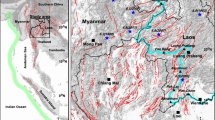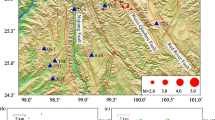Abstract
The Region-Time-Length Algorithm (RTL algorithm) is introduced and improved in the paper. Compared with the original definition, the influence of rupture length on RTL function is emphasized and the weights of epicentral distance function, time function, and rupture length function are ensured to be equal. The retrospective examinations of RTL algorithm in North China have indicated that the anomalies obtained by the improved RTL algorithm show the short or intermediate-short term precursory features in most cases. There are two types of RTL anomalous patterns before the main shock. For the I-type, the variation pattern of theVRTL, numerical values of theVRTL(x, y, z, t) function, is complete and most of them have shown the changing pattern of “rising from 0 “ turning “ dropping” or ”dropping from 0 ” turning ” rising”. For the II-type, the variation pattern ofV RTL is not complete, which increases or decreases quickly from 0 and there is no evident turning, the main shock generally occurs in the short period around the peakVRTL. The rising ofVRTL indicates an increase of seismic activity relative to the background level, which means the enhancement of seismic activity, while the dropping ofV RTL indicates the decrease of seismic activity relative to the background level, which represents the seismic quiescence to a certain extent. According to statistical examination results of RTL algorithm in North China, the methods to distinguish the intermediate and short-term anomalies and to estimate the occurrence time of the coming main shock are given in the paper. For both I and II-type RTL anomalies, the R-value,i.e., the forecasting score, is about 0.6 and 0.3 for the 3 months forecasting period and about 0.7 and 0.4 for the 6 months forecasting period. The preliminary discussion is also made for the influences of characteristic time-spant0, characteristic distancer0, and threshold magnitudeM 0 on computation ofV RTL, as well as some other significant problems in application.
Similar content being viewed by others
References
Chen Qi-fu, Zheng Da-ling, Che Shi eds-in-chief. 2002a.Earthquake Cases in China (1992-1994) [M]. Beijing: Seismological Press, 1–429 (in Chinese).
Chen Qi-fu, Zheng Da-ling, Liu Gui-ping,et al eds-in-chief. 2002b.Earthquake Cases in China (1995-1996) [M] Beijing: Seismological Press, 1–489 (in Chinese).
Chen Qi-fu, Zheng Da-ling, Gao Rong-sheng eds-in-chief. 2002c.Earthquake Cases in China (1997-1999) [M]. Beijing: Seismological Press, 1–468 (in Chinese).
Guo Zeng-jian, Qin Bao-yan. 1991.Cause of Earthquake Formation and Earthquake Prediction [M]. Beijing: Seismological Press, 177–178 (in Chinese).
Huang Q, Sobolev G A. 2001a. Characteristics of the seismic quiescence and activation patterns before theM=7.2 Kobe earthquake, January 17, 1995 [J].Tectonophysics,337: 99–116.
Huang Q, Sobolev G A. 2001b. Seismic quiescence prior to the 2000M=6.8 Nemuro Peninsula earthquake [J].ProcJAcad,77: 1–6.
Jiang Hai-kun, Ma Sheng-li, Zhang Liu,et al. 2003. Spatio-temporal characteristics of acoustic emission during the deformation of rock sample containing fault and barrier [J].Chinese J Geophys,46(2): 291–301.
Jiang Hai-kun, Zhang Liu, Ma Sheng-li,et al. 2002. Spatio-temporal characteristics of acoustic emission during the deformation of rock samples with compressional and extensional en-echelon faults [J].Acta Seismologica Sinica,15(2): 402–413
Mjachkin V I, Brace WF, Sobolev G A,et al. 1975. Two models for earthquake forerunners [J].PureAppl Geophys,113: 169–181.
Ogata Y, Utsu T, Kalsura K. 1996. Statistical discrimination of foreshock from other earthquake clusters [J].Geophys JInt,127: 17–36.
Sobolev G A, Tyupkin Y S. 1997. Low-seismicity precursors of large earthquakes in Kamchatka [J].Volcano Seism,18: 433–446.
Sobolev G A, Tyupkin Y S. 1999. Precursory phases seismicity precursors, and earthquake prediction in Kamchatka [J].Volcano Seism,20: 615–627.
Wang Wei. 2000. The increasing mode for seismic activity and its complexity [J].Northwestern SeismologicalJournal,22(4): 376–381 (in Chinese).
Xu Shao-xie, Lu Yuan-zhong, Zhu Chuan-zhen,et al. 1990.The Guide for Earthquake Forecast [M]. Beijing: Seismological Press, 72–80 (in Chinese).
Zhang Zhao-cheng, Luo Lan-ge, Li Hai-hua eds-in-chief. 1988.Earthquake Cases in China (1966-1975) [M]. Beijing: Seismological Press, 1–222 (in Chinese).
Zhang Zhao-cheng, Luo Lan-ge, Li Hai-huaet al eds-in-chief. 1990a.Earthquake Cases in China (1976-1980) [M]. Beijing: Seismological Press, 1–421 (in Chinese).
Zhang Zhao-cheng, Luo Lan-ge, Li Hai-huaet al eds-in-chief. 1990b.Earthquake Cases in China (1981-1985) [M]. Beijing: Seismological Press, 1–294 (in Chinese).
Zhang Zhao-cheng, Zheng Da-lin, Xu Jing-hua eds-in-chief. 1999.Earthquake Cases in China (1986-1988) [M]. Beijing: Seismological Press, 1–287 (in Chinese).
Zhang Zhao-cheng, Zheng Da-lin, Xu Jing-hua eds-in-chief. 2000.Earthquake Cases in China (1989-1991) [M]. Beijing: Seismological Press, 1–321 (in Chinese).
Author information
Authors and Affiliations
Additional information
Foundation item: National Scientific Project in the Tenth Five-year Plan (2001BA601B01-04-01) and the Encouraging Fund for Excellent Youth in Shandong Province (02BS124) and Chinese Joint Seismological Foundation (102037).
About this article
Cite this article
Hai-kun, J., Hai-feng, H., Huan-peng, Z. et al. Region-time-length algorithm and its application to the study of intermediate-short term earthquake precursor in North China. Acta Seismol. Sin. 17, 164–176 (2004). https://doi.org/10.1007/BF02896931
Received:
Revised:
Accepted:
Issue Date:
DOI: https://doi.org/10.1007/BF02896931




